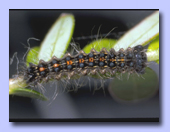 |
 |
 |
|
|
 |
How do growers identify, monitor populations of, and control insect pests? |
|
Lesson Plan: Overview
|
There are many different kinds of insects that can be found on a cranberry bog. Over twenty insects can cause considerable damage to a cranberry crop. These include the cranberry girdler, the cranberry fruitworm, weevils, and cutworms. For the purpose of this lesson, the insect pest focus is on the gypsy moth caterpillar, the black-headed fireworm, the brown spanworm and the false armyworm. It is essential to understand that not all insects found on a cranberry bog are destructive to the cranberry plant. Harmless visitors to the bog include butterflies, some moths, and wasps. Of course, bees are major contributors to the survival of the cranberry crop, serving as critical pollinators. There are also beneficial insects that parasitize the eggs of potential pests. For example, the trichogramma wasp lays its eggs inside the eggs of the cranberry fruitworm. When the wasp eggs hatch, the larvae consume the fruitworm eggs. It is very important, therefore, that insects are not destroyed indiscriminately. Integrated Pest Management (IPM) is a broad based approach to insect control which takes into consideration ecological, societal, and economic concerns. IPM seeks to carefully weigh and intelligently combine multiple strategies to effectively manage harmful pest populations. A critical component of IPM is the cranberry grower’s awareness of the different types (and numbers) of insects - both harmful and beneficial - that are part of the cranberry ecosystem. Sweep netting is one tool that allows farmers to monitor their bogs as they collect, identify, and count their insect population. Typically, cranberry growers sweep net their bogs weekly from the time buds first appear in the early spring until late August when berries are abundant. Once growers understand the nature and makeup of the insect population, they can take carefully considered actions to prevent and limit crop damage. Cranberry farmers utilize a protocol to identify when it is time to take steps to limit harmful insect population. This is called an action threshold. An action threshold is the numerical ceiling advised for a particular pest population. Once that ceiling is reached, growers know to take action. Some pest management strategies include:
Note: Additional information on these methods is provided in the student resource, Growers’ Association Brief, What is IPM? This information is intended for you as well the students to better understand IPM.
|
| Credits |